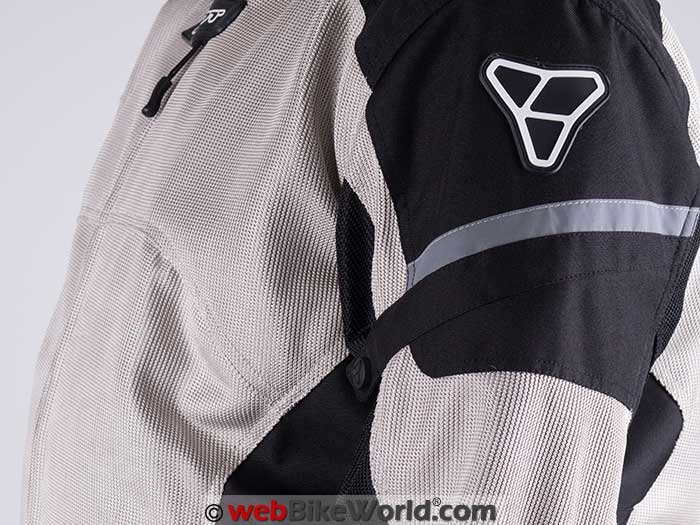The Direct Air Jacket V3 combines free-flowing mesh material with solid textiles in the impact zones. This makes the jacket feel a bit more sturdy than other “full shell” mesh jackets.
But it does so at the expense of some air flow.
Pilot has upgraded the protectors used in this jacket as well as the waterproof liner. It’s now a REISSA membrane lined with polyester mesh. Usability features like Pilot’s Red Tab system and “At Hand” pocket are present and those are details we also really appreciated in the Pilot Trans Urban V2 jacket we reviewed recently.
The Pilot Direct Air Jacket
Although the styling of the Direct Air V3 jacket may not break any new ground, that’s not necessarily a bad thing and there’s a lot going on under the hood that makes this jacket stand out in functionality. The jacket has a “sporty” cut with some mildly curved sleeves that feel just right in the more upright position for touring or sport touring and street riding or adventure riding.
Like the other Pilot gear we’ve reviewed, the Direct Air V3 has minimal branding, with just a small “Pilot” logo on the front over the zipper tab and their three-sided logo on the upper back and shoulders. Six different colorways offer a good variety of looks for the Direct Air V3. These include an all black, red/black, blue/black, Hi-Vis/black, silver/black, and a white/red.
My jacket is the silver and black version, which strikes a nice balance of visibility without being being too “shouty”. Personally, I like the white/red version, as it has the least amount of black exterior surface area. I think this would be best for riding in full sun during hot weather, although the silver shown here is a close second.
On the inside of the jacket shell, Pilot has employed their Red Tab system. This means that all the attachment points for the included waterproof liner as well as openings for pockets are colored bright red so they can be easily spotted.
This same system is used in their other textile apparel and while it seems like a small detail, it is a nice touch that I’m glad to see has been carried over to this jacket. The Direct Air V3 includes a pants connection zipper that will directly connect to the Pilot Omni Air pants (review) to make a complete two-piece mesh suit.
Of course, other Pilot pants will connect as well, so you can mix-and-match depending on the need. In addition to the connection zipper, Pilot has provided a snap loop that can be fastened around a belt. This is a useful way to create a pants connection in a pinch if the jacket is worn with jeans or similar pants.
Pilot Direct Air V3 Shell Construction
The shell of the Direct Air V3 jacket is a combination of mesh and solid textile with what looks like about a 50/50 combination. The front and rear panels and the interior facing sides of the sleeves are made from what Pilot calls Pilotex 210D micromesh. This mesh material is a tighter weave than the textile used on jackets like the Joe Rocket Phoenix.
At the same time, the weave is not as small as others like that used on some Cortech or Tourmaster jackets. It’s somewhere in between and the material does feel very sturdy and flexible for a mesh textile.
The rest of the outer shell is made from Pilot’s Pilotex 600D textile, which is is also used on portions of their Trans Urban V2 jacket. On the Direct Air V3, this material is used on the anterior facing portions of the forearms, the shoulders and neck area as well as the sides and lower back spaces.
Many details present on the Trans Urban V2 jacket have found their way to the Direct Air V3 also. All of the snaps are covered in rubber to avoid scratching the bike’s bodywork and all of the zippers used through the jacket are quality YKK items. A small red loop is placed just inside the collar for keeping a headphone or intercom wire in place and there are two red tabs on the inside left interior marking the opening of two stacked pockets.
There is a also a Napoleon style pocket in the left side called out with a bright red zipper. The collar is made from the 600D Pilotex material but it has some soft padding sewn inside the main body of the collar while the top edge is covered with a soft neoprene. This attention to the collar area is nice to see and Pilot excels at providing details like this in their gear.
Like other products I’ve had the chance to review, the construction is very neat and the stitching is all tight and even. I did find one pulled thread at the bottom of the rear outer shell but that was all.
In the lower rear section of the interior is a connection zipper for attaching to Pilot branded pants, but both sides of the zipper are provided in case you want to mate the jacket to a different brand of pants.
The interior is lined with a light weight polyester mesh for a smooth and soft feel over most of the interior. The pockets for the shoulder and elbow protectors use a quilted nylon material for good durability. But since these spaces are under portions of the solid Pilotex material in the shell, they don’t prevent any air flow, as it wouldn’t have made it inside the jacket in these locations anyway.
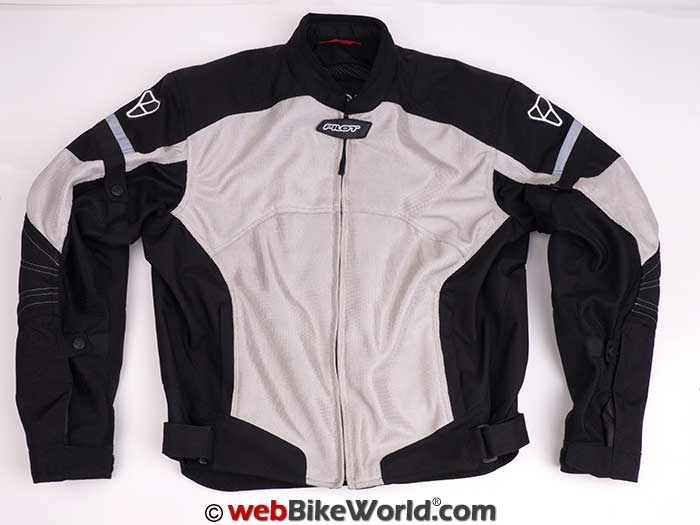
Sizing and Fit
This Direct Air V3 jacket is a size Large and I expected it to fit like the Trans Urban V2 jacket I recently reviewed and that means a fairly generous size. The opposite turned out to be true. This jacket fits more closely in the chest than its non-mesh sibling.
My 43.5 inch chest seems to fill the upper portion of the jacket without excessive slack, so I’d say the maximum recommendation of 44″ for the size L is a good bet. I like this type of trim fit in a mesh jacket, otherwise it can tend to flap in the breeze more than a solid textile (or leather) jacket, due to the more flexible nature of the mesh material.
The waist adjusters easily handle my 36 inch waist and they can expand for 3-4 more inches at least. There are no mid-height adjusters but the cut is pretty generous in the upper belly space. It was a bit loose in this area for me so adjusters would have been nice here, but it still fits well overall.
The arm lengths also seem correct for a jacket in this size but I found that the bicep space was rather bulky, even using the smallest setting on the adjuster, as you can see in the photos. Perhaps I need to work out more! The collar is the short height type but it lacks a closure. It works well to fit a variety of neck sizes but I would prefer a snap or hook-and-loop closure here. I have been the unfortunate host to two bees and a wasp in the past few years that have made their way down my jacket collars when riding in the summer. Both jackets had an open collar design not much different from the Direct Air V3. Of course your luck may be different than mine.
Bottom line? I’d say the sizing chart for the Pilot Direct Air V3 is accurate. If you have a size 44 chest, the jacket should fit but you won’t get much underneath it beyond a single layer.
If you plan on using the jacket for commuting where you might be wearing an undershirt and a collared shirt, moving up a size might be necessary. But for me, this jacket works perfectly on its own or with a light layer underneath.
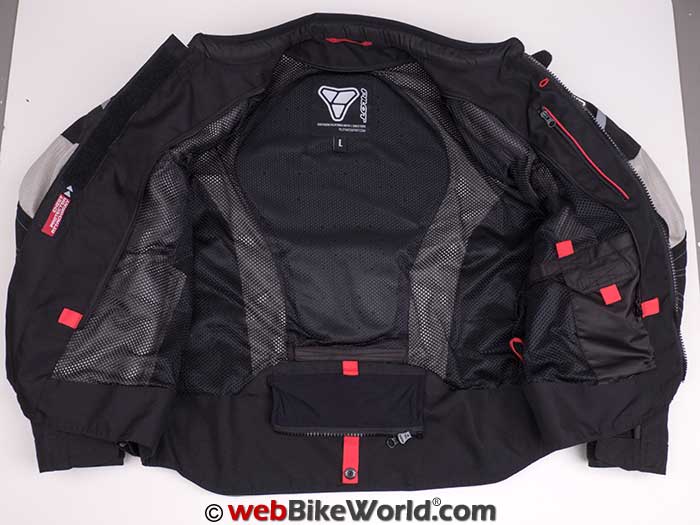
Zippers
The main closure for the jacket is handled with a large coil-type YKK zipper and the pull includes a tethered plastic material that is textured for easy gripping with gloves. At the top of the closure is a rubber tab that covers the closed zipper pull and fastens via hook-and-loop. This tab is one of the locations where you can see the Pilot branding.
The zippers used to close the front pockets are the small coil type and their fine-tooth pitch prevents the zipper from scratching when inserting your hand in the pocket. A zipper of similar size and pitch is used for the Napoleon pocket on the inside left of the shell as well as for the “At Hand” pocket on the left sleeve and also the long zipper used for attaching the waterproof liner.
The pants connection zipper is very large in pitch and has a large metal pull tab that is easy to find and slide while reaching behind the back.
Adjusters
Adjusters on the Pilot Direct Air V3 are located at the waist on each lower side of the jacket above the hips. These 1.5 inch (3.8 cm) wide straps adjust from 8 inches (20 cm) down to 5.0 inches (12.7 cm), providing a total of 6 inches or 15.25 cm of adjustment. There are two-position snap adjusters on the sleeves at the forearms and biceps to cinch the sleeve close to the arms.
At the wrist is a hook-and-loops adjuster strap that takes the sleeve opening from 12 inches (30.5 cm) down to a miniscule 6 inches (15.25 cm).
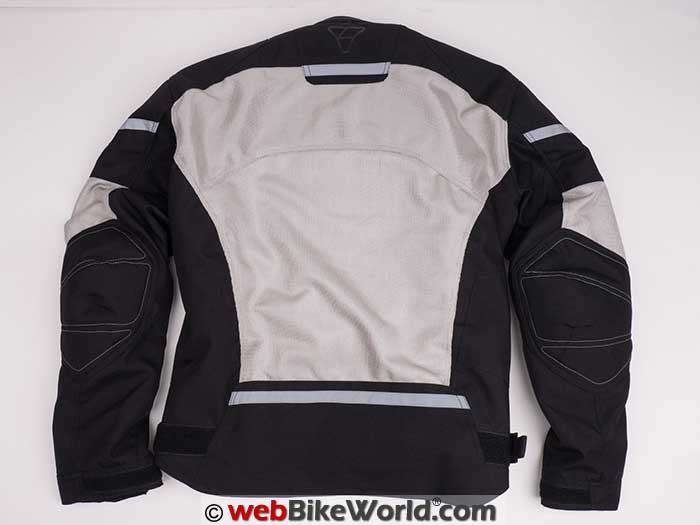
Pockets
There are two hand warmer style pockets on the front of the jacket. These two pockets have 5.75 inch (14 cm) openings so they are a little tight for my size medium hands to reach into when wearing gloves and I’d still like a little more room even without gloves. On the inside left portion of the jacket are two pockets, with one stacked on the other. The larger is 7 inches (17.8 cm) wide and the smaller one on top of it is 4 inches (10 cm) wide.
Both close with hook-and-loop fastener, with the smaller pocket doing so with a flap while larger just pulls together two sides of the opening. These two interior pockets are duplicated in the included waterproof zip in liner.
This makes it easy to find the pockets when not looking in the jacket, as they are in the same location and are of the same size. It is important to note that these pockets are mesh for some or all of the pocket interior, meaning that none of the pockets are waterproof.
However, the pockets in the waterproof liner should be fully waterproof as they sit entirely inside the liner. There is one additional pocket at the end of the left sleeve that is made from the Pilotex 600D material. This “At Hand” pocket is small and can hold keys, a credit card and money clip or maybe even a small wallet.
This small pocket is a great feature that we first discovered on the Trans Urban jackets and it’s nice to see it in place here. It might even be water resistant as the material here is not mesh, but it is not guaranteed. I like the idea of this easy-to-access pocket but I would like it even more if it was available on the right sleeve instead (or both sleeves).
 Protectors
Protectors
Like the Trans Urban V2 jacket, the protectors in the Direct Air V3 have received an upgrade. The new polyurethane armor bits use a rate-sensitive material, so they are normally soft and pliable but become stiff when receiving an impact.
The protectors are CE rated and are used in the shoulders and elbow impact zones. The back pad, however, is just a simple foam piece which might provide a small amount of impact protection but it would be minimal at best and it is not CE rated. The back pad is removable however, so it can be replaced and/or upgraded if desired. Pilot offers their own CE certified back insert as a $40.00 option.
The Forcefield Pro Level 2, size 001 (available here) fit the earlier version of the Direct Air jacket, so it should also fit the V3. The shoulder and elbow protectors are also removable. Beyond the protector inserts, extra Pilotex material is in place in the elbow areas and it feels like it has a soft filling in the space between the layers.
It may be some light batting material or it is possible that it is just the way the layers feel together.
Chest Protection
Like other jackets from Pilot, the Direct Air V3 includes a provision to attach a chest protector for increased safety. There is a large patch of hook-and-loop fastener on the inside of right main closure panel, designed for use with the Pilot Core Chest protector. The chest protector comes in two sizes, Full and Micro, and both are compatible with the Direct Air V3 jacket.
Chest protectors are often overlooked by street riders (including me) but they are important since chest impacts are more common than back impacts for street riders during a crash.
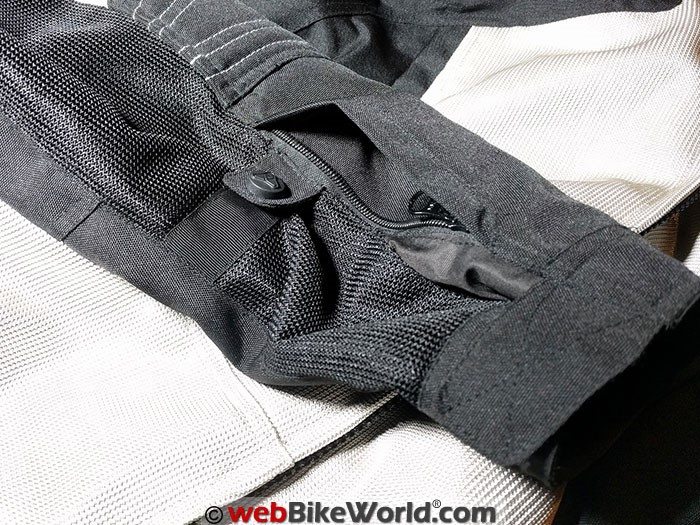
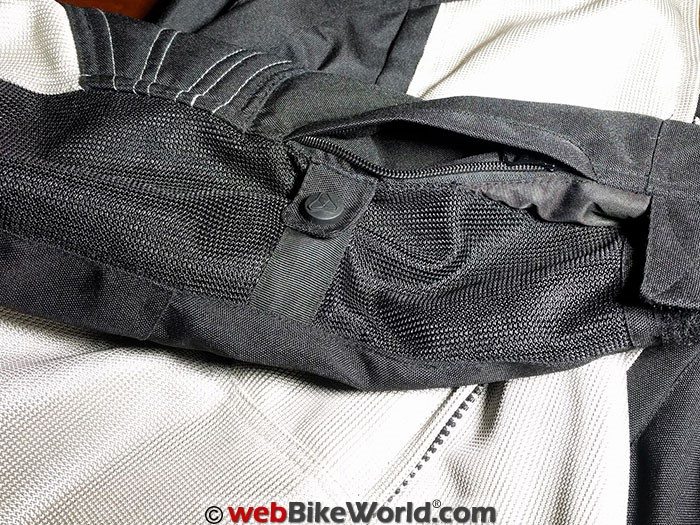
Reflectivity
Night time visibility is handled by several 3M Scotchlite panels on the jacket shell, just like the original Direct Air jacket. There is a horizontal strip on each shoulder and a short stripe at the upper back. Additionally, there is a long 13 inch (33 cm) strip across the lower back as well.
These Scotchlite strips all reflect very well but the mesh material has some good reflectivity as well. This may be specific to the silver color of this jacket but while testing the reflectors, I noticed the silver mesh shows up nicely too.
Removable Liner
The full-length wind- and water-resistant liner zips in completely around the front, going around the neck and back down. This is a nice feature that keeps the liner firmly in place. It also attaches with “RedTab” marked loops at the sleeve cuffs and there are even two more loops along the bottom at the rear hem to make sure the liner is securely fastened.
Actually, if you don’t fasten any of the loops and just use the wrap-around zipper in the front, it makes the liner a lot easier to remove or replace. You’ll have to hold the liner sleeve cuffs with your fingers when you pull your arms in or out if you do this, but it makes for fast in/out if the weather is variable.
With the liner installed, the jacket blocks a lot of air and I rode with it back when the weather was closer to 60 than the 90 it is today. So the Direct Air jacket could be used from Spring until Fall and that’s another advantage. I haven’t been out in the rain with the jacket but this type of system that’s designed mostly for maximum air flow and where you have what is basically a mesh jacket shell, will obviously not provide any protection from the rain.
So the water-resistant liner is all you have. If you think it’s going to rain, the jacket will provide some protection with the liner installed, but you may also want to carry a waterproof outer shell, like the excellent Tourmaster Sentinel rain jacket (review).
Ventilation
The primary purpose of a mesh riding jacket is to allow as much air flow as possible while providing protection in the event of a crash. The difficult part is that mesh fabric by its nature is probably going to provide less abrasion resistance than a solid textile of the same weight.
Pilot took a hybrid approach to the Direct Air V3 jacket by using large panes of mesh in the front, rear and interior facing sides of the sleeves. The rest of the jacket shell employs Pilotex 600D, which is a durable non-mesh textile. The solid areas obviously prevent air from flowing directly through but they will most likely take more punishment than the mesh layer alone. As such, the air flow is good in comparison to most mesh jackets I’ve owned that use a similar hybrid design.
For ultimate ventilation, an all-mesh shell like the Joe Rocket Phoenix jacket (review) is the way to go. Years ago my first mesh jacket was a Phoenix and the large open weave of the shell gave a feeling of hardly wearing a jacket at all.
Since that time though, I’ve grown to appreciate the higher abrasion resistance of the hybrid approach versus the ultimate air flow of all mesh. So I’m satisfied with how the Pilot Direct Air V3 jacket feels in the mid 80’s F (30C) temperatures we’re experiencing right now where I live. The air flowing through the jacket at speed does a good job of keeping me cool but the shoulder areas get a bit warm whether in I’m in motion or not.
Maybe if a lighter color instead of black were used in those spots this wouldn’t be as noticeable.
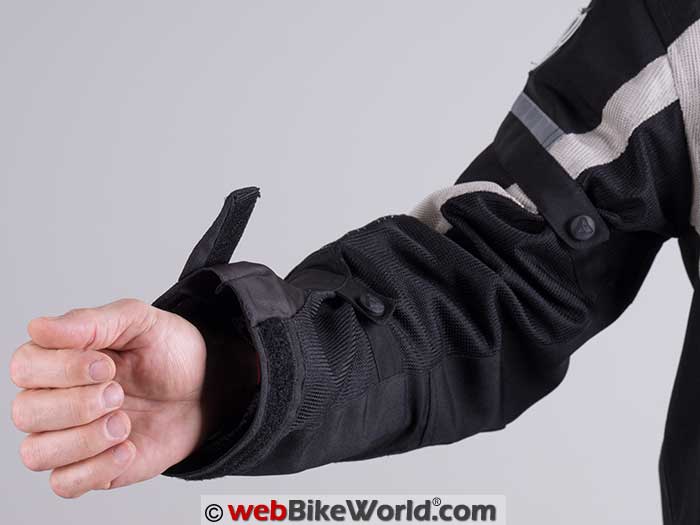
Waterproof Liner
Pilot includes a removable waterproof REISSA liner with the Direct Air V3. It attaches via a zipper and snap loops to provide a waterproof and breathable barrier for when the weather turns wet. Pilot’s Red Tab system is used to mark all the attachment points, so it is easy to find the snap loops in the sleeves and the lower inside area of the torso. The beginning of the zipper track is also marked with a red color tab for easy identification in the otherwise black interior.
Of course, with the liner in cooling will be greatly reduced as air can no longer directly reach the skin. It is “breathable”, but like most of the waterproof and breathable textiles, air flow is highly restricted.
The removable REISSA liner in the V3 is an opportunity to examine the REISSA material itself, which I couldn’t do directly in the Trans Urban jacket because that liner was attached in-between the jacket shell and interior liner, making it inaccessible.
The REISSA liner is a very thin material that doesn’t have the rubbery or plastic bag feel of some other brands of breathable membranes. It does feel a bit delicate though and Pilot was concerned about this as well. To help increase the durability, they attached a polyester mesh lining to the interior of the REISSA liner, similar to that inside the jacket shell. This makes it less likely to snag and damage the REISSA membrane.
Out of curiosity, I tested the liner by placing a section of it over bowl and adding several ounces of water on top of the liner. After letting it sit for over an hour (95 minutes), no water had made its way through and the underside was completely dry.
This is not a scientific experiment and it may be a different story when exposed to rain drops traveling at highway speeds, but it’s a good indicator that the liner should do the job in the rain. And one more thing: the REISSA liner is so thin and light that it can be stored most anywhere.
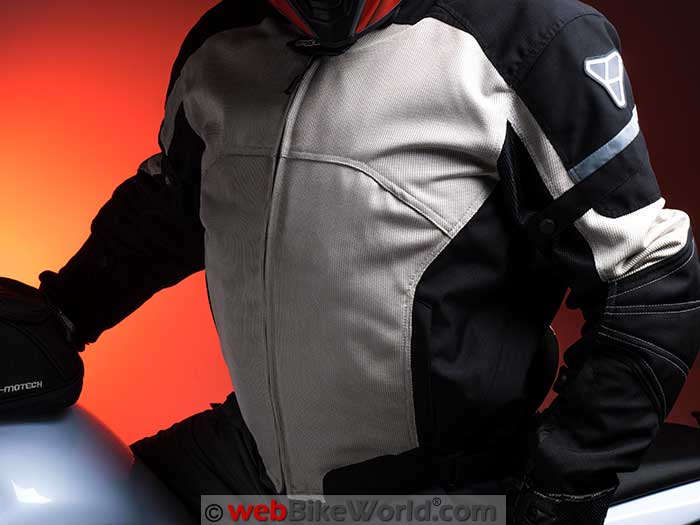
Conclusion
The Pilot Direct Air jacket V3, like many products we’ve seen from Pilot Motosports, represents a good value at a list price of just $160.00, only $10.00 up from the original. There is a lot of competition in the sub-$200.00 space for mesh riding jackets but the Direct Air V3 definitely has some features that help it stand out.
Form follows function in the design of the Direct Air V3 and while there is a good selection of colors, the styling is nothing earth-shattering.
The good stuff is what you may not see at first, like the Red Tab system, which makes it easier to find attachment points and pockets in subdued lighting. Also, the Pilot “At Hand ” pocket is a great idea that we’ve liked since we first encountered it on the Trans Urban jacket.
Pull tabs on the waist adjusters and the use of high-quality materials and hardware (YKK zippers for instance) will give the owner a feeling that it will last a long time and that it was designed for “real world” usage.
Throw in the lightweight and effective REISSA waterproof liner and you’ve got a versatile mesh jacket that provides a great balance of safety and comfort.
And that $160.00 includes a two-year warranty, so you really can’t go wrong.
Also: Pilot Dura Overpants Review | Pilot Direct Air Jacket Review


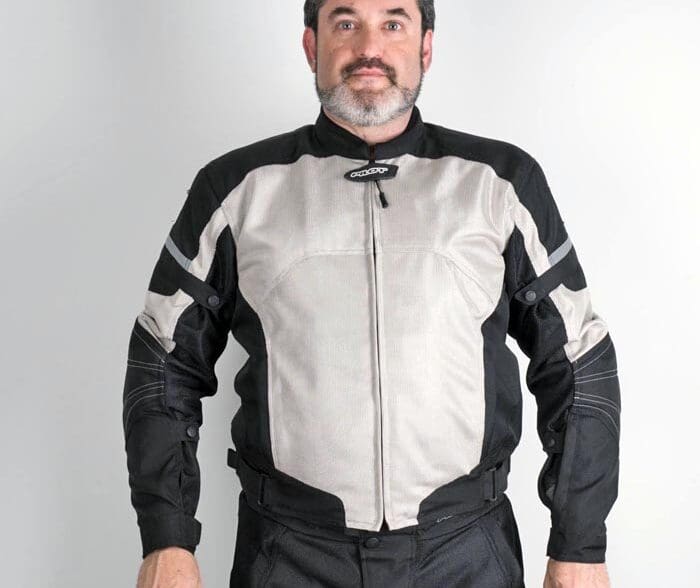
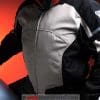
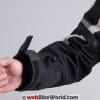
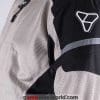
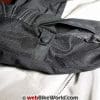
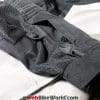
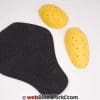
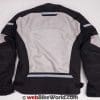
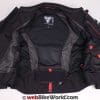
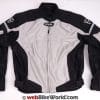
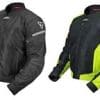


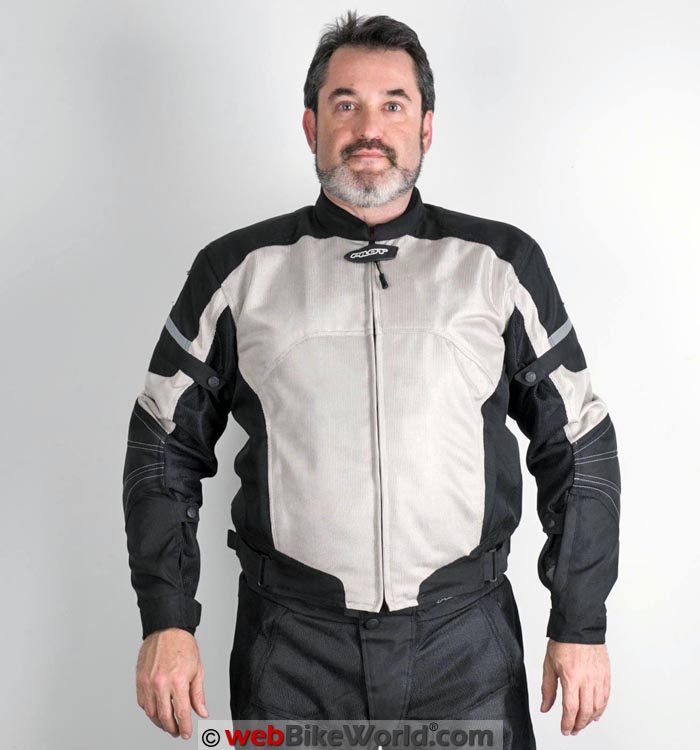
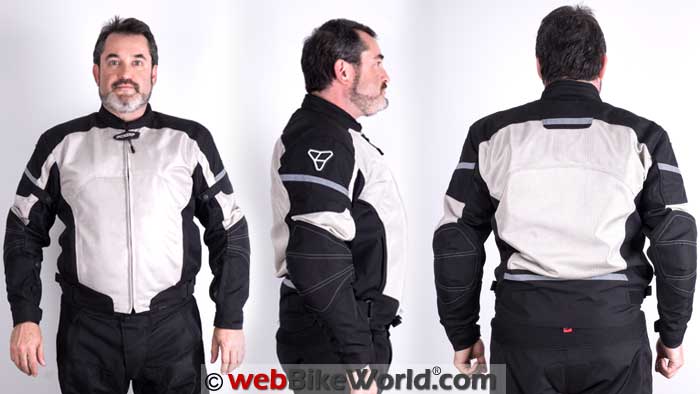
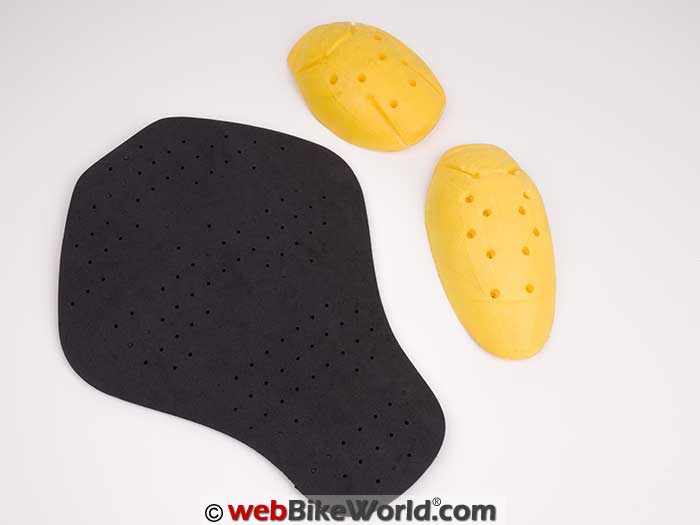 Protectors
Protectors